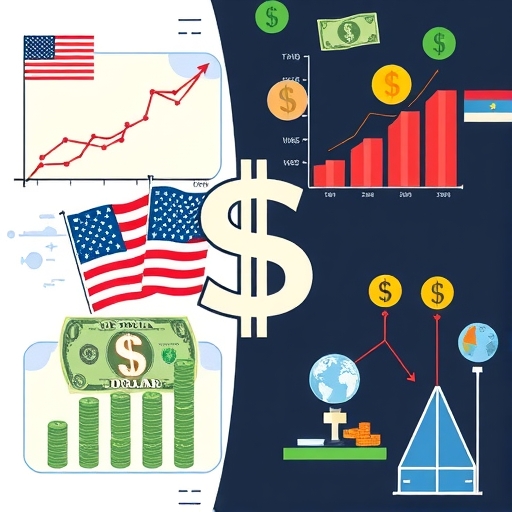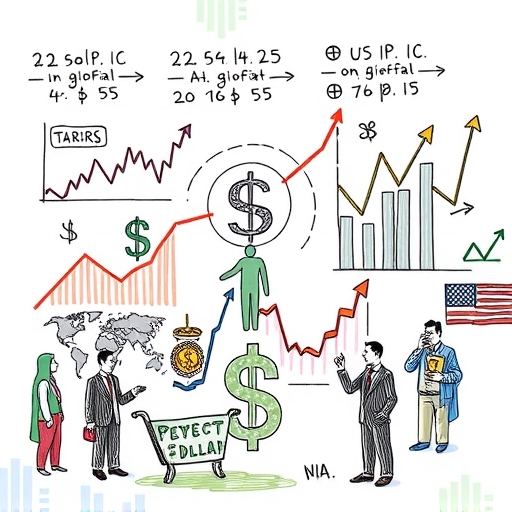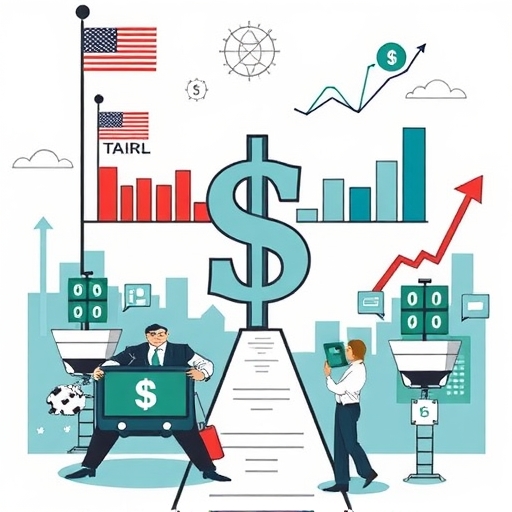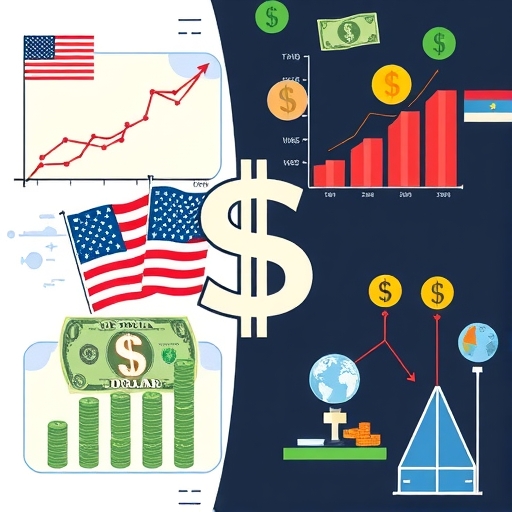Navigating the US Dollar’s Crossroads: Tariffs, Policies, and Your Trading Strategy
The United States Dollar (USD) stands as the undisputed heavyweight in global finance, serving as the primary reserve currency and dominating international trade. Yet, like any major currency, its value is constantly shaped by a complex interplay of domestic policies, global economic trends, geopolitical shifts, and market sentiment. For us as traders and investors, understanding these dynamics isn’t just academic; it’s fundamental to navigating the foreign exchange (forex) markets and protecting our portfolio’s value. Today, we’re looking at the current landscape for the US Dollar, examining the key forces at play and what they might mean for its future direction.
Right now, the Dollar’s path feels particularly uncertain. We see strong underlying economic indicators alongside looming policy debates, especially concerning tariffs, and the ongoing strategic shifts by major central banks. Overlaying this are persistent geopolitical tensions that traditionally bolster the Dollar’s safe haven status, though their recent impact has been somewhat muted. So, how do we dissect these converging factors and understand the potential trajectory of the USD? Let’s break it down together.
Key factors influencing the US Dollar include:
- Global economic indicators: Understanding the broader global economic context is critical.
- Monetary policies: Insights into decisions made by the Federal Reserve and other central banks shape the Dollar’s value.
- Geopolitical tensions: Events and conflicts around the world can prompt safe haven movements towards the Dollar.
The Tariff Tug-of-War: A Potential Game Changer for the US Dollar
One of the most significant policy discussions impacting the current US Dollar outlook revolves around potential new tariffs. Proposals for broad, universal tariffs have sparked considerable debate among economists and market participants. We need to understand what these proposals entail and, more importantly, how they might realistically affect the US economy and, consequently, the Dollar’s value.
Think of tariffs like a tax on imported goods. When a country imposes tariffs, it makes those imported products more expensive for domestic consumers and businesses. The idea behind them is often to protect domestic industries or to gain leverage in trade negotiations. However, the economic consequences can be far-reaching and, crucially for the Dollar, have varied and debated impacts.

Analyst views on the impact of potential tariffs on the USD are notably divided. Some argue that tariffs, by making imports more expensive and potentially boosting domestic production (or at least domestic prices), could be inflationary. If the Federal Reserve were to react to this increased inflation risk, it might be compelled to maintain higher interest rates for longer, or even consider hiking rates if inflation pressures become acute. Higher interest rates typically make a currency more attractive to foreign investors seeking higher returns, potentially leading to a stronger Dollar. This is one side of the argument – that tariffs could lead to a Dollar bounce or support its strength.
Decoding the Economic Impact: Tariffs, Inflation, and the Dollar’s Value
On the other hand, many analysts see tariffs as a significant economic headwind. By raising costs for consumers and businesses, tariffs can act like a tax on the domestic economy, potentially dampening consumer spending and investment. For companies reliant on imported components, tariffs can squeeze profit margins or force price increases, which can reduce demand. Such economic slowing could undermine the case for higher interest rates and even push the Fed towards cuts sooner, which would typically weaken the Dollar.
Moreover, tariffs can trigger retaliatory measures from other countries, leading to trade wars that disrupt supply chains and reduce export opportunities for US businesses. This further weakens the economic outlook. Prominent investors like Warren Buffett have expressed concerns about policies that could erode the value of the US Dollar, and tariffs are certainly among those potential erosive forces by potentially disrupting global trade balances and economic stability.
There’s also the question of whether the market has fully priced in the potential effects of future, widespread tariffs. Some analysts believe the market is complacent, underestimating the negative economic ripple effects. If this is the case, the Dollar might be more vulnerable than current valuations suggest. Conversely, others might argue that the uncertainty itself creates a premium for the Dollar as markets brace for volatility, or that the protectionist angle is already partially reflected in certain asset flows.
The debate is complex because the outcome depends on several variables: the *extent* of the tariffs, the *reaction* of other countries, the *response* of the Federal Reserve, and the *resilience* of the domestic economy. For you as a market observer, it’s vital to follow these discussions closely, understanding that tariffs are not just a trade issue but a significant potential driver for the USD and related currency pairs.
The Federal Reserve’s Influence: Rate Policy and the Dollar’s Pulse
Perhaps the most consistent and powerful driver of the US Dollar’s value is the monetary policy set by the Federal Reserve (the Fed). Their decisions on interest rates and the management of the money supply have direct and profound impacts on currency valuations. The Fed’s actions are constantly scrutinized by markets worldwide, and their forward guidance provides crucial signals for USD traders.
Recently, the Federal Reserve maintained its policy rate, a decision widely anticipated by the markets. However, the signals about *future* rate movements are what truly capture attention. The Fed’s economic projections, often summarized in the “dot plot,” provide insights into policymakers’ expectations for interest rates in the coming years. We’ve seen projections indicating potential rate cuts further out, perhaps in 2025 and 2026, which offers a longer-term perspective on the potential direction of US monetary policy.
Federal Reserve Chairman Jerome Powell’s statements are always critical. His recent remarks linking potential tariffs to increased inflation risk are particularly noteworthy. This direct acknowledgement from the head of the central bank suggests that future trade policy is on the Fed’s radar and could influence their decisions regarding interest rates. If the Fed perceives tariffs as a significant source of upward pressure on prices, they might become more cautious about cutting rates, or even consider the possibility of tightening if inflation becomes entrenched. This potential policy response to tariffs adds another layer of complexity to the Dollar’s outlook.
| Monetary Policy Decisions | Projected Actions | Implications for Dollar |
|---|---|---|
| Maintain current rate | Stability in existing monetary policy | Potential for short-term strength |
| Future rate cuts | Expectation of easing monetary policy | Weaker Dollar forecasted |
| Tightening due to inflation | Potential increase in interest rates | Stronger Dollar likely |
Beyond the policy rate, the Fed’s approach to its balance sheet, through processes like Quantitative Tightening (QT), also influences liquidity in the financial system, which can have indirect effects on the Dollar. By reducing its holdings of bonds and other assets, the Fed effectively removes money from the system, potentially leading to higher borrowing costs and a stronger Dollar, all else being equal. The pace and duration of QT are therefore also important considerations.
Beyond the Fed: How Global Central Banks Shape USD Pairs
While the Federal Reserve is a primary focus, the value of the US Dollar isn’t determined in a vacuum. It’s always quoted and traded against other currencies. Therefore, the monetary policy decisions of other major central banks are equally important, as they influence the *relative* attractiveness of the Dollar compared to the Euro (EUR), British Pound (GBP), Japanese Yen (JPY), Swiss Franc (CHF), and others.
Consider the Bank of England (BoE). When the BoE holds its policy rate steady, as it has done recently, while expectations exist for the Fed to potentially cut rates in the future, this dynamic impacts the GBP/USD pair. If the BoE holds firm while the Fed signals upcoming cuts, the relative yield differential might narrow or even shift, influencing capital flows between the two currencies. Similarly, the Swiss National Bank (SNB) recently cutting its sight deposit rate had a notable impact on the USD/CHF pair, typically leading to a strengthening of the Dollar against the Franc as the interest rate differential widened in the Dollar’s favor.

The Bank of Japan (BoJ) is another critical player. Speculation about potential shifts away from ultra-loose monetary policy in Japan, including possible future rate hikes, significantly impacts the USD/JPY pair. A move towards tightening by the BoJ would likely narrow the substantial interest rate gap between the US and Japan, which has been a major factor driving USD/JPY higher in recent years. Any such shift would be a major event for the forex market and could lead to significant Yen strengthening against the Dollar.
Understanding these divergent monetary policy paths is crucial for anyone trading currency pairs involving the Dollar. We need to constantly monitor not just what the Fed is doing, but what other central banks are doing and *expected* to do, as these relative movements in interest rates and policy stances are key determinants of exchange rate dynamics.
Fiscal Sustainability: The Long-Term Question for the Dollar’s Value
While monetary policy focuses on interest rates and money supply, fiscal policy, which involves government spending and taxation, also plays a significant role in the long-term health and value of a currency. Concerns about the US government’s fiscal situation have been raised by prominent figures and rating agencies, adding another layer of scrutiny to the Dollar’s outlook.
When a government spends more than it collects in taxes, it runs a budget deficit. Persistent deficits accumulate into national debt. The US national debt has grown significantly over the years. While the US, with its large economy and reserve currency status, has historically been able to manage high debt levels, the sheer scale and projected future growth of the debt have become points of concern for some.
Legendary investor Warren Buffett has voiced worries about the “eroding value” of the US Dollar, attributing this partly to increased government spending and tax cuts that contribute to the national debt. His concern stems from the idea that high and rising debt could, in the long run, put pressure on the government to either inflate its way out of the debt (effectively reducing the real value of the debt and the currency) or face potential challenges in financing its obligations. While the latter scenario seems remote for the US Dollar currently, the underlying principle – that excessive debt can undermine confidence in a currency’s long-term stability and purchasing power – is valid.
| Debt Concerns | Impact on Currency | Potential Outcomes |
|---|---|---|
| Rising debt levels | Increased risk perception | Lower confidence in USD |
| Budget deficits | Potential inflationary pressures | Vulnerability to fiscal challenges |
| Government spending | Influence on monetary policy | Pressure on interest rates |
Debt Concerns, Credit Ratings, and Confidence in the Dollar
The link between national debt and currency value is also reflected in credit rating assessments. Agencies like Moody’s and S&P Global Ratings evaluate a country’s ability and willingness to repay its debt. Downgrades to a country’s credit rating, such as the one the US received from Fitch in 2023 (though Moody’s has maintained its rating while changing its outlook), can signal increased risk perception among investors. While a US downgrade doesn’t automatically cause the Dollar to plummet, it contributes to a narrative of potential fiscal challenges that can weigh on long-term sentiment and confidence in the currency.
High levels of government debt require ongoing financing, often through the issuance of government bonds (like US Treasuries). Increased supply of bonds to finance deficits can, in theory, put downward pressure on bond prices and upward pressure on yields. While US Treasuries remain a cornerstone of global finance, persistent concerns about fiscal sustainability could, over time, influence demand and yields, indirectly affecting the Dollar’s relative attractiveness compared to other assets or currencies perceived as having stronger fiscal footing.

For long-term investors, the erosion of purchasing power due to potential currency devaluation linked to fiscal issues is a real concern. This is why assets like gold, which is often seen as a store of value independent of any single currency’s performance or government’s fiscal health, are sometimes suggested as a way to protect wealth against Dollar devaluation risks. While the immediate impact of debt figures on the daily forex market can be less direct than interest rate announcements, the fiscal trajectory is a critical factor for the Dollar’s value over months and years.
Geopolitics as a Market Driver: Uncertainty and Safe Havens
In times of global uncertainty, political instability, or conflict, investors often seek refuge in assets perceived as safe. The US Dollar has historically held the primary position as the ultimate safe haven currency. This status stems from the size and stability of the US economy, the depth and liquidity of its financial markets, and the perceived security of US government debt.
When geopolitical tensions flare up, such as conflicts in the Middle East or other regions, we typically see a flight to safety. This often translates into increased demand for US Dollars and US Treasuries, pushing the Dollar’s value higher against other currencies, particularly those of countries more directly impacted by the instability or those perceived as having weaker economic or political foundations.
The reasoning is straightforward: in a crisis, capital tends to flow to places where it is perceived to be safest. The US financial system is vast and liquid, and US government bonds are considered among the lowest-risk investments globally. This demand for USD-denominated assets provides a natural support for the Dollar during periods of heightened global risk aversion.
Is the Dollar Still the Ultimate Safe Haven in the Current Climate?
While the Dollar’s safe haven status is well-established, its performance during recent periods of tension hasn’t always resulted in significant, sustained gains. There are several potential reasons for this. Firstly, the nature of the current uncertainties is multifaceted; it includes not just geopolitical conflict but also economic policy risks (like tariffs) and domestic political volatility in the US itself. These domestic factors can sometimes counteract the traditional safe haven bid.
Secondly, other potential safe havens exist, including gold, the Japanese Yen, and the Swiss Franc, although their relative appeal can fluctuate. Furthermore, the sheer complexity of the global economic outlook, with differing growth trajectories and monetary policy stances across regions, can sometimes dilute the impact of a pure flight-to-safety trade focused solely on the Dollar.
Nevertheless, geopolitical risk remains a significant factor in the Dollar’s performance. While it might not always lead to dramatic spikes, underlying tensions contribute to market caution and can provide a floor under the Dollar during sell-offs driven by other factors. For us, monitoring global political developments is an essential part of forming a comprehensive view on the USD.
Navigating the Uncertainty: Investor Sentiment and Your Strategy
Given the confluence of factors we’ve discussed – the tariff debate, divergent central bank policies, fiscal concerns, and geopolitical risks – it’s understandable that investor sentiment towards the US Dollar is currently mixed and potentially shifting. Recent reports suggest that investor sentiment might be turning bearish on the US Dollar, partly due to concerns surrounding the potential volatility associated with future policy directions, particularly regarding tariffs.
Investor sentiment isn’t just an abstract concept; it directly influences trading flows and market movements. If a consensus builds that the Dollar is likely to weaken, traders will position themselves accordingly, selling USD against other currencies, which can accelerate a decline. Conversely, if sentiment is broadly bullish, buying pressure can push the Dollar higher.
For you as an investor or trader, understanding this sentiment and how it’s being shaped by the macroeconomic and political landscape is crucial. Are market participants overly optimistic or pessimistic about certain outcomes? Are potential risks, like the full impact of tariffs or fiscal challenges, being adequately priced in? Your own analysis of these factors will inform your trading strategy, whether that involves trading USD pairs directly, considering assets like gold as a hedge, or adjusting exposure to USD-denominated assets.
If you’re looking to act on your market views or explore the opportunities presented by currency fluctuations, selecting the right trading platform is a key decision. If you’re just starting out in foreign exchange or looking to expand your trading horizons, then Moneta Markets is a platform worth considering. Based in Australia, they offer access to over 1000 financial instruments, catering to both beginners and seasoned traders.
Navigating currency markets in the current environment requires careful analysis and risk management. Divergent central bank paths mean relative value is constantly shifting. The potential for disruptive policy changes, like widespread tariffs, adds layers of uncertainty that demand vigilance. Furthermore, the long-term fiscal picture warrants consideration for anyone holding Dollar-denominated assets over extended periods.
Conclusion: What Does it All Mean for Your Approach to the Dollar?
The US Dollar today sits at a complex crossroads. It remains a powerful currency, backed by a large economy and its reserve status. Yet, its path forward is clouded by significant policy debates, particularly around tariffs, the nuanced signals from the Federal Reserve regarding future rate cuts (and the potential influence of tariffs on those decisions), ongoing concerns about the national debt and fiscal sustainability, and the ever-present backdrop of geopolitical risk.
As we’ve seen, analyst views are divided, and investor sentiment is sensitive to new information. There’s no single, simple answer to the question of where the Dollar is heading. Its trajectory will be determined by how these major forces interact and evolve over time. Will tariffs be enacted, and if so, what will be their true economic fallout and the Fed’s reaction? Will global central banks continue to diverge in their policy paths? How will fiscal pressures evolve, and how will markets react to them? Will geopolitical events drive strong safe haven flows into the Dollar, or will other factors dominate?
Our goal here hasn’t been to give you a definitive forecast, but rather to equip you with the framework for understanding the key drivers of the US Dollar right now. By focusing on policy developments (monetary and fiscal), trade dynamics, geopolitical events, and market sentiment, you can develop your own informed perspective. Stay curious, keep learning, and remember that successful navigation of the currency markets comes from continuous analysis and adaptation.
If you’re looking for a broker that offers robust tools to trade currencies and other assets while keeping these global factors in mind, Moneta Markets stands out. It supports popular trading platforms like MT4, MT5, and Pro Trader, offering competitive features such as high-speed execution and low spreads, contributing to a better trading experience as you analyze and react to market movements.
us dollar todayFAQ
Q:What factors currently affect the US Dollar’s value?
A:The value of the US Dollar is influenced by tariffs, central bank policies, geopolitical tensions, and fiscal health.
Q:How do tariffs impact the US economy and the Dollar?
A:Tariffs can raise costs for consumers and businesses, potentially leading to inflation or a downturn in economic activity, which in turn affects the Dollar’s value.
Q:What is the Federal Reserve’s role in determining the Dollar’s worth?
A:The Federal Reserve’s monetary policies, including interest rate decisions and balance sheet management, have significant impacts on the USD’s valuation.

留言